I have not fond any, only impedance curves of the complete enclosure (IE other side of the passive filter). That don't tell e lot....
I wasn't aware that you wanted impedance measurements of raw drivers in cabinet. You can find that in my DB folder in opening post of this thread. It is precise as much as DATS V2 measuring tool allows.
Last edited:
First, I want to thank-you for all your care.I wasn't aware that you wanted impedance measurements of raw drivers in cabinet. You can find that in my DB folder in opening post of this thread. It is precise as much as DATS V2 measuring tool allows.
Sadly, I can do nothing from your drop box, no way to download, no way to copy the two file.txt.
Ok, i'll upload two impedance files here, on the forum. Just say if you want .tzz files that you can open in DATS software or .zma ?
I am curious. What kind of music do you listen to and in what format? My coaxials are quite implacable with bad recordings, widespread evil in commercial music for decades.
Mainly Jazz or R'n'r. FlACs. Some are digital copies of my own digital mixes, that, of course I know very well and had listened on a lot of various pro and average speakers.I am curious. What kind of music do you listen to and in what format? My coaxials are quite implacable with bad recordings, widespread evil in commercial music for decades.
The problem is there is a peak in the treeble that makes every drums to sound thin like a tambourine, a piano like an harpsichord, voices nazal and aggressive etc.. And VERY few recordings sound as expected.
The tweeter is exceptional, (apart an excess of extrème treeble ?) but the medium-bass speaker is a mess. No body, no consistency. I can hear the resonance of its membrane where it breaks. And the contrast between the two is terrific to my ears. It is a pity, because the precision of the micro dynamic is exceptional, close to the one of my big system.
But there is very few records I can listen with those speakers with pleasure. Even with my TV that they were intended to be used for: I prefer to continue to listen with its poor internal speaker.
It is a pity that Kef do not provide an equaliser with those speakers, instead of their strange tunings.
Well your speakers should have a problem. If you can, return them.
Amazing sound quality, offering real benefits compared to the original LS50
Amazing sound quality, offering real benefits compared to the original LS50
Edit: These speakers do benefit from some hours on them. Reserve your final judgement until they've had substantial run-in. If the 30 day return policy is of concern to you I'd leave music playing 24/7 for several days before doing any critical listening, perhaps even as much as a full week. Also, these speakers are certainly resolving enough to benefit from cable upgrades if you're so inclined. That said, using the cables that are included in the box will give you world-class sound. But.. if you use Bluetooth you'll only be getting a fraction of what these speakers are capable of when compared to the USB or the Toslink/Optical input.
Edit: Once they get 100 hours or more on them, you may find that the "large room" bass setting- even in a truly large room- is too much for most modern recordings that already have an elevated bass to begin with. I've found that even though my room is large, setting the speakers at the medium room is best for 90% of recordings. I only adjust the bass in the app for thinly recorded music that sounds slightly more well-rounded with a little bass bump. You'll be amazed how articulate, deep and well defined the bass goes once these speakers are fully broken in. I seriously have no idea how they did it. I cannot imagine that there is a better home audio system in today's market for @ $2000.00. I think that this speaker system could change home audio forever- it's that revolutionary.
They don't have a specific problem: they are both the same. Believe-me I know when a speaker or an amp have a problem.Well your speakers should have a problem. If you can, return them.
But, yes, they do have a real problem, a problem of conception. The proof is their directivity; if you change slightly you listening position (vertical in close listening) they change day and night their tonal balance.
May-be, as a sound engineer, I'm more sensible to the quality of the restitution than ordinary people, and know better how a given record is supposed to sound ?
Btw, thanks for the gift, but I cannot open the archive: tried with 2 different downloads.
Last edited:
I do not have this problem with my KEF Q100. When the music excites me, I stand up, turn off the lights and go around the room. If it is an orchestra, I will direct it.
RAR file.
Windows & Gnu/Linux: 7-zip Download
How to Install and Use 7zip on Ubuntu Linux
Mac: The Unarchiver | Top Free Unarchiving Software for macOS
Keka - the macOS file archiver
RAR file.
Windows & Gnu/Linux: 7-zip Download
How to Install and Use 7zip on Ubuntu Linux
Mac: The Unarchiver | Top Free Unarchiving Software for macOS
Keka - the macOS file archiver
Last edited:
Mainly Jazz or R'n'r. FlACs. Some are digital copies of my own digital mixes, that, of course I know very well and had listened on a lot of various pro and average speakers.
The problem is there is a peak in the treeble that makes every drums to sound thin like a tambourine, a piano like an harpsichord, voices nazal and aggressive etc.. And VERY few recordings sound as expected.
The tweeter is exceptional, (apart an excess of extrème treeble ?) but the medium-bass speaker is a mess. No body, no consistency. I can hear the resonance of its membrane where it breaks. And the contrast between the two is terrific to my ears. It is a pity, because the precision of the micro dynamic is exceptional, close to the one of my big system.
But there is very few records I can listen with those speakers with pleasure. Even with my TV that they were intended to be used for: I prefer to continue to listen with its poor internal speaker.
It is a pity that Kef do not provide an equaliser with those speakers, instead of their strange tunings.
Measurement 0, 12.5 and 25 degrees off axis of LS50W. Hardly any peaking of tweeter and very consistant set of curves. Quite maches my measurements of modified LS50.
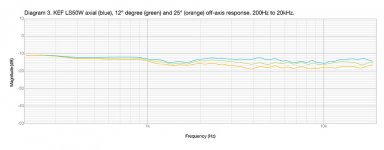
I think you either have faulty product (in which case you should replace it) or you are trolling. So, what is it ?
Can you measure frequency response - 50cm distance is enough for gate to be set at around 3ms so we can see if there is a real problem. Given that you are sound engineer, mic and sound card shouldn't be a problem.
Last edited:
Measurement 0, 12.5 and 25 degrees off axis of LS50W. Hardly any peaking of tweeter and very consistant set of curves. Quite maches my measurements of modified LS50.
View attachment 757618
I think you either have faulty product (in which case you should replace it) or you are trolling. So, what is it ?
Can you measure frequency response - 50cm distance is enough for gate to be set at around 3ms so we can see if there is a real problem. Given that you are sound engineer, mic and sound card shouldn't be a problem.
About speakers, I will never look at response curve to get an idea about how they sound. So many speakers with quite similar response curve that sound day and night. See what I mean ?
No, not a question of the sources themselve. I used many DACS, many devices in comparison (my main system, headphones, car sound system, PC. etc.) to try to understand my problems with those speakers. It makes a difference in micro dynamic, never on the tonal balance. All my other speakers are quite balanced. NOT those Kef.
And don't believe it is auto suggestion, oer any preconception against this brand: I worked with Raymond Cook and had a lot of confidence with the Kef products a a preconception: A total surprise.
Not to forget i was very excited about their innovating coaxial speaker, one of the reason i had spend my money blind on those speakers.
Last edited:
i do use 7zip, but under windows. Usually working fine.[How to Install and Use 7zip on Ubuntu Linux
Attachments
Thanks Zvu.
Great that it turned out that the tweeter filter also works well with coils DCRs more typical for air coils. Later I noticed that in my schematic I have DCRs generated for core coils, and these should be rather avoided in the tweeter circuit.
Adding a cap in parallel to the woofer coil is a good idea, it gains over a dozen of dBs attenuation of the breakup frequency (I would possibly consider adding a small resistor in series with the cap to avoid shorting for HF)
troelsgravesen.dk Coils for loudspeakers
Tweeters
Most often we have a single coil in parallel with the tweeter, e.g. 2nd and 3rd order filters, and anything from 0.2-0.5 ohms usually goes goes well here. However, these coils are usually small and getting 0.15-0.30 ohms coils is no problem. I suggest coils wound from 0.5-0.8 mm wire.
........
Adding a cap in parallel to the woofer coil is a good idea, it gains over a dozen of dBs attenuation of the breakup frequency (I would possibly consider adding a small resistor in series with the cap to avoid shorting for HF)
No shorting up to 50kHz. First thing a crossover must be is to be safe. Here's impedance:
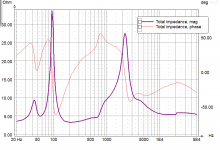
Though i had to add a resistor in that place for my Kef R300 crossover. Impedance was about 3 ohm at 20kHz but lower after that. 5 ohms if i remember. It was 2.7uF capacitor with purpose to kill the 2kHz resonance of woofer.
Last edited:
This guy seems to have the same faulty product !I think you either have faulty product (in which case you should replace it) or you are trolling. So, what is it ?
YouTube
I can hear the exact same defects even across my PC speakers.
Maybe it interests some:
YouTube Review ! KEF Q100 vs Q150 !
PS: my modded Q100 sounded better first and much better after my last mod, Summer 2018.
YouTube Review ! KEF Q100 vs Q150 !
PS: my modded Q100 sounded better first and much better after my last mod, Summer 2018.
KEF LSX active speaker has been tested and measued extensively in Stereophile. Atkinson has now added room measurements etc. (June 2019 issue). Seems like the friendly people at KEF have now voiced LSX a bit more mainstream, out of BBC monitor tradition. KEF LSX wireless loudspeaker system John Atkinson June 2019 | Stereophile.com
LSX = red
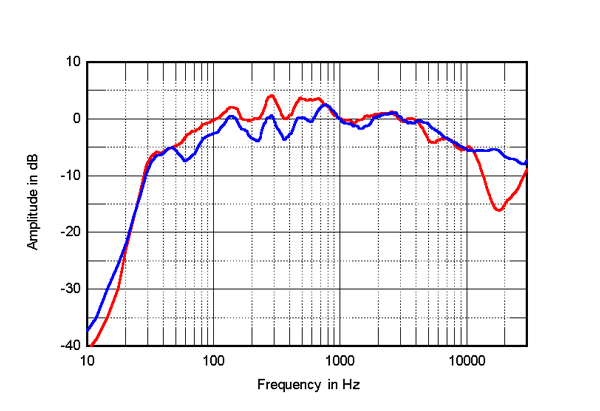
As a teaser, typical room response of 3-way floorstanders, (both Wilson Audio)
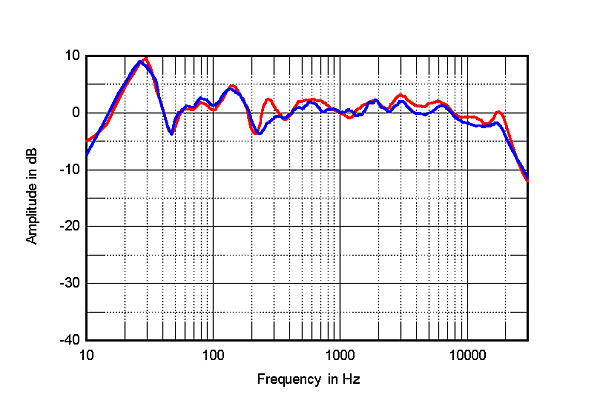
LSX = red

As a teaser, typical room response of 3-way floorstanders, (both Wilson Audio)

Last edited:
I'm guessing that the reason for that is because they don't intend to push LSX as a studio monitor that sounds good in home but just another active WiFi, BT enabled home loudspeaker. They obviously don't measure as good as their other speakers with tangerine phase plug tweeters. Port is lousy with resonance as high as that.
Design of that green one with red tweeter dome is beautiful though. I mean, how cool are these little fellows...
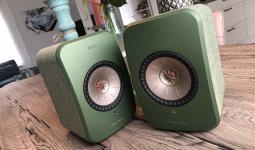
Design of that green one with red tweeter dome is beautiful though. I mean, how cool are these little fellows...

Last edited:
- Home
- Loudspeakers
- Multi-Way
- KEF LS50 playground - measurements of raw drivers in factory cabinets and simulations
